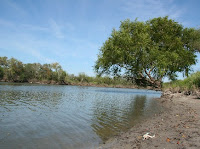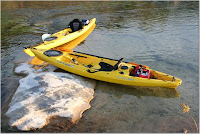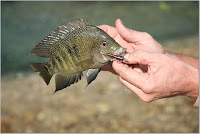
It was kind of like the
Antiques Road Show Sunday, only better; at the
Texas Natural Science Center at UT, staff and volunteers manned tables labeled with signs like: "Vertebrate Paleontology," and "Sea Creatures," and "Rocks and Minerals."

Patrick and Tamara and I made the journey uptown with a heavy bag of rocky stuff -- a year's worth of collecting here and there -- to confirm independent (and sometimes informed) guesses and third-party IDs, and to get the skinny on some things that were complete mysteries to us.
Vince and Barbara Terracina, our friends and neighbors, were already there with their kids when we arrived.

Saturday, Vince and his next-door neighbor and good friend Richard, took the Terracina kids to a road cut in Hays County that Vince and I explored last weekend on the way back from the Nueces River. We met the Terracinas and Richard (and Maggie, the good dog) there.
We arrived early at the site high on a county road south of US Hwy 290, and Vince apologized when he got out of his car: "Sorry to ruin the peace and quiet."
Tamara and I agreed the "noise" of the kids was preferable: "Daddy, Daddy! This is a
really good spot!" and "Daddy! Look at what I found!" and "Mr. Richard, can we go over there?!"
"I can't believe I haven't brought the kids out here before," said Vince.

And -- truly -- it is an amazing site. When we first arrived, Patrick was eager to skip lunch and get right to collecting.
"I'll give you one minute," I said. "See if you can find a fossil."
In 40 seconds he was back with five good specimens.
Most of the fossils in our bag -- including those from the incredibly rich site in Hays County -- were marine invertebrates; steinkerns (interior molds) of clams and snails.

One of the most common is a bivalve that is often called a "Texas heart" or "deer heart;" the molds may be of any one of several related animals. One of ours is
Granocardium pseudopendens.
Among the most spectacular finds at the Hays County site were a handful of echinoderms; asymmetrical sea urchins in the genus
Hemiaster.
The best specimens retain the bumpy surface where fuzz (not spines, in this case) attached to the critter, and clearly show the "star" recognizable today on contemporary sand dollars.

Among the other treasures we had identified were the little Cretaceous oysters called
Ilymatogyra arietina -- we call them "Devil's toenails," which is a name most folks give to another genus altogether of extinct oysters .
We also identified a rare (for that period) brachiopod known as
Kingena wacoensis.

Patrick was particularly proud of his example of a scallop still embedded in a limestone matrix. The shell, from the genus
Pecten had been mineralized as chert and quartz, and sparkles under the light.
Patrick sees in the shell fossils proof positive that central Texas was once under water. He's right, of course; during the
Cretaceous period (from about 165 million years ago to about 45 million years ago), Texas and much of North America was covered by a shallow sea called the Western Interior Seaway.

In 2001, the
Intergovernmental Panel on Climate Change's Third Assessment Report predicted that by 2100, global warming will lead to a sea level rise of 9 to 88 cm (that's ... uh, 3.5 inches to nearly a yard).
The geologic record kind of puts things into perspective, doesn't it? I mean, the Hays Co. site is about 1,000 feet above the current sea level. (And yes, I know about eustatic and isostatic changes ... but do we really want to get into all that here? No? I didn't think so.)

In a sense, much of the limestone around (and beneath) us here is fossil
something; calcerous planktons and algae and bivalves and brachiopods and gastropods and corals ....
Much of it is compressed and undifferentiated; in places where it is not, like in the Hays Co. road cut, we find fossils.
The vertebrate paleontologist at Sunday's event, Dr. Pamela Owen, identified one Corpus Christi Ship Channel bone as a piece of the plastron (bottom shell) of a land tortoise, and another as a rib bone from the extinct giant sloth.

The museum has a complete reconstructed skeleton of that impressive animal on the bottom floor. It's about the size of a Mini Cooper.
Many of our spoil island finds are associated with the
Pleistocene epoch, the geologic time period from about 1.8 million years ago to just 11,500 years back.
In Texas, it was characterized by mega-mammals like giant beavers, mastodons, glyptodons (a huge armadillo species), sabre- and scimitar-toothed cats, short-faced bears, mammoths and the like. The coast was then more or less where it is now (the Texas barrier islands mostly formed since then, but the dune line was just a dozen or so miles farther inland, near where bay shores now are).

Some of my favorite fossils, from both the coast and the Hill Country, are the ichnofossils, or
ophiomorpha -- trace fossils created by the burrows of mud shrimp or crabs or other critters.
Some of the fossils we brought in were so nondescript (weathered or otherwise altered) as to defy easy identification.
"Well, it's some sort of bivalve," one of the paleontologists said of one steinkern.
"I knew that when I got up this morning," Tamara remarked later.

It was great fun, though, to watch how respectfully and seriously the volunteers treated all of the treasures kids of all ages brought to them. One little girl brought her favorite rock to be identified by the fellow from the Bureau of Economic Geology.
The geologist questioned her about where she found it, and examined the perfectly smooth, triangular, white specimen carefully -- first with his naked eye, then under a microscope. Finally he carefully handed it back to her and said: "Well, I'd say it looks like you have a very fine piece of limestone there."

Perhaps the most fun, for me anyhow, was listening to a TPWD expert explain the history of something that was interesting from neither a geological nor biological standpoint: an early archaic spear point I found some time ago.
The point, he said, was made of central Texas chert and had been traded or washed downstream to South Texas, where I found it. It had been resharpened, several times, and some of the resharpening took place while it was still attached to the haft of the spear.
It was amazing to watch and listen as the archeologist brought to life events that took place 5,000-7,000 years ago, right here in Texas.

I think humans are by nature -- still -- hunters and gatherers; at least I am. I am also, by nature, a taxonomist -- I want to name and categorize things.
Finding fossils (or artifacts, for that matter) and then getting expert help in identifying them and the context in which they originally existed satisfies both of those deep-seated needs.
Plus, it's just a heck of a lot of fun.
 As the deadline approached for my latest RoadTripAmerica.com contribution, I asked Tamara: "What's so great about Austin, anyway?"
As the deadline approached for my latest RoadTripAmerica.com contribution, I asked Tamara: "What's so great about Austin, anyway?"





























